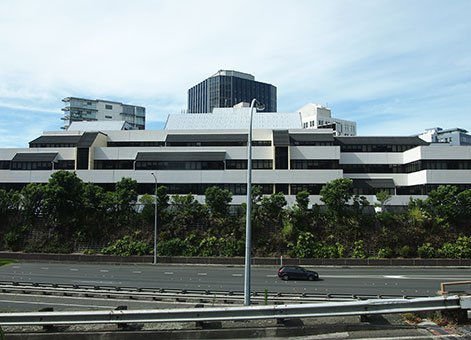This Wellington building, opened in 1982, was the first office building in the world constructed using the "base isolation” principle for earthquake resistance. It was also known as the William Clayton Building.
In the 1960s and 1970s two Department of Scientific and Industrial Research (DSIR) scientists, Ivan Skinner and Bill Robinson, came up with the concept of “base isolation” and developed it for practical application.
The Ministry of Health Building, designed by the Ministry of Works and Development and built by James Wallace Pty Ltd, was the first chance to incorporate this earthquake resilience technology into a large scale building. It had previously been used in the South Rangitikei Viaduct and other bridges.
Seismic isolation technology means the Ministry of Health Building should be more able to come through major earthquakes without structural damage. The “base-isolators” separate the building from the ground, letting it move horizontally in a controlled way. This motion greatly reduces the level of acceleration felt within the building, reducing the prospect of damage and personal injury.

Ministry of Health Building from Tinakori Road, Wellington, February 2014. Engineering New Zealand.
Originally the whole superstructure, including the basement, was supported on 80 leadrubber bearings. During an earthquake the building was capable of 150 millimetres of movement in any horizontal direction. Special separations were provided at all points of interface of the building with surrounds to ensure freedom to move during earthquake shaking.
This technology proved successful and has been incorporated into thousands of buildings around the world where there is a high likelihood of earthquakes. Other Wellington examples include Parliament Buildings, which was retrofitted with “base isolation” in the early 1990s, and the National Museum of New Zealand Te Papa Tongarewa, which was completed in 1998 and has 152 “base isolator” bearings.
In 2015 a major redevelopment of the Ministry of Health Building began. The original stepped look of the building will disappear as floors are extended to create flat lines more typical of office buildings.
Heritage recognition
IPENZ “Engineering to 1990” project
This item of New Zealand’s engineering heritage was recognised as part of the IPENZ “Engineering to 1990” project, which the Institution organised to help celebrate the country’s sesquicentenary in 1990. A plaque was unveiled to mark the significance of the base isolation used in this building as part of the development of the nation.
More information
Access
This office building is located at the northern end of Molesworth Street and can also be seen from the Wellington Urban Motorway.
Location
133 Molesworth Street, Wellington.
